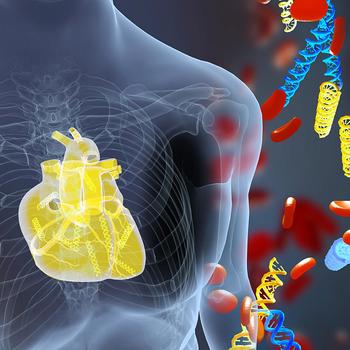Each year, approximately 500 children in the U.S. undergo heart transplantation. These children face considerable stress.
Undergoing a biopsy—an invasive procedure using a catheter to remove a piece of the transplanted heart to test it—is just one way such patients are poked and prodded. Cardiac biopsies are a necessary evil, serving as the primary way doctors detect if a heart is likely to be rejected. But now George Mason University and the Inova Health System are teaming up to develop ways to make that determination with noninvasive techniques.

“On average, children pediatric heart transplant patients undergo approximately 10 biopsies within the first year of transplant…and more if they have rejection,” said Jason Goldberg, MD, MS, a pediatric cardiologist and research fellow at Mason. “That's a big deal, especially since taking a child to the hospital is no small thing. They have to go under anesthesia, they have to have needles stuck in them. It's quite traumatic, and diagnosing rejection in a noninvasive manner may help start treatment before the patient is sick and not feeling well.”
Cardiologist Palak Shah, MD, an adult heart-transplant specialist who serves as Goldberg’s research mentor at Inova, has worked with colleagues both at Inova and Mason to evaluate the potential of microRNA (miR) to provide clues on whether heart transplant recipients are at risk for rejection. miR are small, noncoding RNA molecules that impact the regulation of gene-expression.
Shah and his team published a paper in 2022 that was cause for optimism. The researchers found that “miRs are promising genomic biomarkers in cardiovascular medicine, have the potential ability to detect heart transplant rejection, and may provide mechanistic insights into molecular pathways modulated during rejection.”
“MicroRNA is a type of transcription factor, which is a protein that turns specific genes ‘on’ or ‘off’ by binding to nearby DNA,” explained Goldberg. “And it's encoded to a certain degree to do what the body needs, so when you measure the microRNA, you can get a sense of what the body is doing—essentially it's a molecular biomarker. What Palak and others found is that there are microRNA signatures correlating with heart transplant rejection.”
Goldberg is now using the technique to test children who have received new hearts. He and his colleagues at Mason and Inova received a grant from the Enduring Hearts Foundation, which includes collaboration with colleagues at the University of Pittsburgh Medical Center who have bio-banked blood samples taken at the time of biopsy. The biomarkers are validated by looking simultaneously at the microRNA taken at the same time as a rejection or nonrejection biopsy.

The new pediatric developments are being supported by a partnership between Inova and the Mason Statistics Collaboration Core (SCC), which is providing the mircoRNA analysis. This and other collaborative projects require machine learning and other advanced statistical techniques utilized by Mason faculty and graduate students.
Goldberg said that the collaboration is mutually beneficial. “Mason has great research and science but no medical school, whereas Inova has great medicine but lacks significant biomedical academic partnership," said Goldberg. "With the two organizations working together it creates a lot of runway for research.”
Goldberg is one the first members of a postdoc program for Inova clinician-scientists interested in developing skills in statistics and data science. “I'm a pediatric heart transplant physician and I've been taking care of patients for nearly 15 years,” he said. “But I was at a point in my career where I really caught the research bug, and it hasn’t gone away."
Palak, Goldberg's mentor, has ongoing collaborations with Jiayang Sun, chair of Mason's Department of Statistics, and Carolyn Drews-Botsch, chair of the Department of Global and Community Health in Mason's College of Public Health. Sun is the Mason PI and Drews-Botsch is the Co-PI for this special joint postdoc program with Inova Health System.
“This pioneering program between Mason and Inova uniquely trains the next generation of medical research scientists in collaborative research and some essentials in data science, statistics, or epidemiology to address the challenges of the AI and information revolution," said Sun. The program features dedicated mentors from Mason in the fields of statistics, epidemiology, and global health, along with top physicians and researchers at Inova.
Goldberg is enthused about the new development, and most importantly, the increased longevity it may bring to young patients with critical heart disease. “When I was in my cardiology fellowship, we thought that the big change in heart transplantation would be that we wouldn't have to do it anymore, that there would be stem cells and other fancy machines that wouldn't require the use of donor organs. But time and time again, nothing has really worked to replace heart transplantation.
“It has become clear that the next frontier for our patients includes personalized medicine where molecular biomarkers and therapies can evaluate ongoing pathology and define specific treatments before significant illness develops. I am proud to be part of this work at Mason and Inova.”
